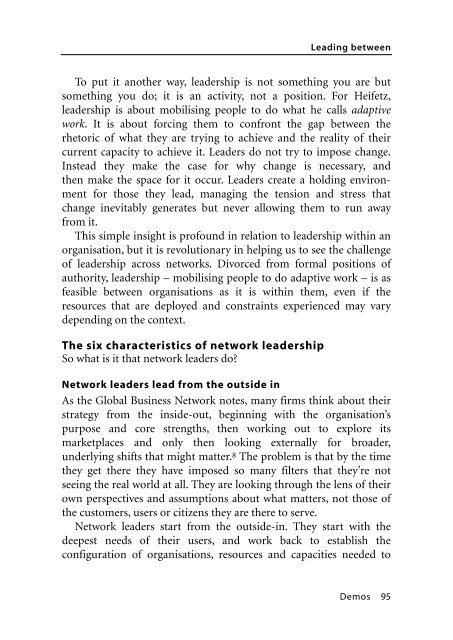Network Logic - Index of
Network Logic - Index of
Network Logic - Index of
You also want an ePaper? Increase the reach of your titles
YUMPU automatically turns print PDFs into web optimized ePapers that Google loves.
To put it another way, leadership is not something you are but<br />
something you do; it is an activity, not a position. For Heifetz,<br />
leadership is about mobilising people to do what he calls adaptive<br />
work. It is about forcing them to confront the gap between the<br />
rhetoric <strong>of</strong> what they are trying to achieve and the reality <strong>of</strong> their<br />
current capacity to achieve it. Leaders do not try to impose change.<br />
Instead they make the case for why change is necessary, and<br />
then make the space for it occur. Leaders create a holding environment<br />
for those they lead, managing the tension and stress that<br />
change inevitably generates but never allowing them to run away<br />
from it.<br />
This simple insight is pr<strong>of</strong>ound in relation to leadership within an<br />
organisation, but it is revolutionary in helping us to see the challenge<br />
<strong>of</strong> leadership across networks. Divorced from formal positions <strong>of</strong><br />
authority, leadership – mobilising people to do adaptive work – is as<br />
feasible between organisations as it is within them, even if the<br />
resources that are deployed and constraints experienced may vary<br />
depending on the context.<br />
The six characteristics <strong>of</strong> network leadership<br />
So what is it that network leaders do?<br />
Leading between<br />
<strong>Network</strong> leaders lead from the outside in<br />
As the Global Business <strong>Network</strong> notes, many firms think about their<br />
strategy from the inside-out, beginning with the organisation’s<br />
purpose and core strengths, then working out to explore its<br />
marketplaces and only then looking externally for broader,<br />
underlying shifts that might matter. 8 The problem is that by the time<br />
they get there they have imposed so many filters that they’re not<br />
seeing the real world at all. They are looking through the lens <strong>of</strong> their<br />
own perspectives and assumptions about what matters, not those <strong>of</strong><br />
the customers, users or citizens they are there to serve.<br />
<strong>Network</strong> leaders start from the outside-in. They start with the<br />
deepest needs <strong>of</strong> their users, and work back to establish the<br />
configuration <strong>of</strong> organisations, resources and capacities needed to<br />
Demos 95
















